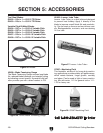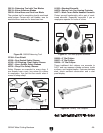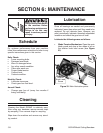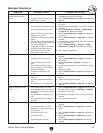
G9744Z Metal Cutting Bandsaw
-27-
The following tips will help you safely and effec-
tively operate your bandsaw, and help you get the
maximum life out of your saw blades.
Tips for horizontal cutting:
• Use the work stop to quickly and accurately
cut
multiple pieces of stock to the same
length.
• Clamp the material firmly in the vise jaws to
ensure
a straight cut through the material,
and use the positive lock to speed produc-
tion.
• Let the blade reach full speed before engag-
ing
the workpiece.
• Never
start a cut with the blade in contact
with the workpiece, and do not start a cut on
a sharp edge.
•
Chips should be curled and silvery. If the
chips are thin and powder like, increase your
feed rate.
• Burned chips indicate a need to reduce your
blade speed.
• Wait until the blade has completely stopped
before
removing the workpiece from the vise,
and avoid touching the cut end—it could be
very hot!
• Support long pieces so they won't fall when
cut, and flag the ends to alert passers-by of
potential danger.
• Adjust the blade guides as close as possible
to the workpiece to minimize side-to-side
blade movement.
• Use coolant when possible to increase blade
life.
Operation Tips
NOTICE
Loosen blade tension at the end of each day
to prolong blade life.
You need to change coolant when you notice
the following conditions:
• Low sump level
• Abnormal appearance (change in fluid color)
• Foul smell (rancidity)
• Floating matter on the fluid (chips, swarf,
mold)
• Tramp
oil floating on the surface (leaking
machine and hydraulic oils)
• Excessive foam (improper mixture, too high
of pressure, excessive air in system)
• Dirty machine or trenches (cleaners in the
fluid have become depleted)
• User notices skin irritation
• User has respiratory irritation
• Other problems that might be fluid related
are:
—rust
on machine or part
—staining on machine or part
—tool failure due to loss of coolant perfor-
mance
—growth
of fungi that would block coolant
flow
—change
in coolant viscosity (thicker or thin-
ner
—accumulation
of water at the bottom of the
sump in straight oils
—dirt and grit suspended in coolant
—general loss of performance (burning part
or tool)
Consult your coolant manufacturer and MSDS for
complete use and disposal information.


















